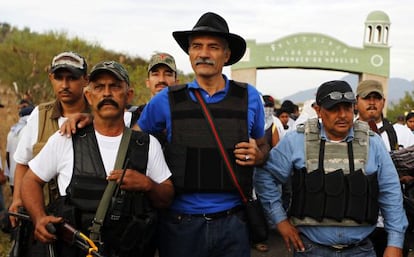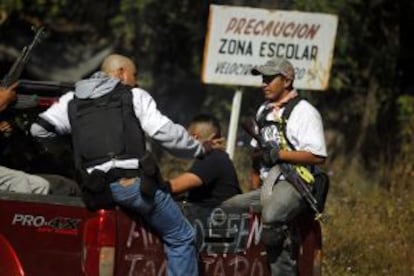Vigilante forces make headway across various Mexican towns
Armed groups of citizens want to rid Michoacán state of powerful drug cartel’s control

When some 200 men and women entered the Michoacán town of Parácuaro on Saturday, they were received with a hail of bullets, which came from the rooftops of the nearby buildings. One of them died in the confrontation but the rest of the civil vigilantes were able to make it to the headquarters of the local police, where they captured 11 officers and locked them up in cells.
Parácuaro, a town of about 25,000 residents, is the 10th municipality in the state to have fallen under control of vigilante groups in recent months. They explained that they took up arms because they were tired of growing crimes being committed by the drug cartels in the region.
What is occurring in Michoacán is similar to an ongoing war. Last year, some 990 people were killed in Michoacán – the highest homicide rate in 15 years for one of the most violent states in Mexico. In comparison, there were 78 murders in Spain in 2013.
In one major incident, gunmen ambushed a deputy admiral of the Mexican navy, Carlos Miguel Salazar, as he was heading back on a rural road to his command post in Puerto Vallarta in neighboring Jalisco state after spending a short vacation in Michoacán. His bodyguard was killed, and his wife and driver were seriously wounded.
Salazar was the highest- ranking military official to be killed since the government’s offensive on the cartels began seven years ago.
Michoacán was also the site where, in 2006, a group of masked men rolled five decapitated heads across the floor of a local bar in the first most gruesome incident to have taken place in the drug war. The practice has been repeated in other states.
Some days ago, five bodies with their throats slit were found in the state capital, Morelia.
Michoacán is one of the major production areas of marijuana and meth, and an important transshipment point for cocaine headed to the United States.
Now, the self-defense groups control a fifth of the state’s territory. Last November, the federal government sent in the army to Lázaro Cárdenas port because of growing instability. But with 11 months on the advance, the vigilantes are just one step away from taking Apatzingán, the state’s economic and political seat, which they tried to capture last October.

“The taking of power in various municipalities in Michoacán by civil vigilantes is equivalent to a mini-coup in a regional government,” explained Raymundo Riva Palacio, a journalist who specializes in security issues.
The state has been under siege by different cartels, which have long been battling for power and control. First the Sinaloa and Zetas fought each other until 2006, when La Familia Michocana, a mafia clan with a pseudo-religious ideology, appeared on the scene.
The family’s founder, Nazario “El Chayo” Moreno, even wrote an indoctrinating manual for his members to follow. After then-President Felipe Calderón announced El Chayo’s death in December 2010, a new cartel, Los Caballeros Templarios, appeared. It was organized from the remaining members of La Familia, preserving the cult around its founder but changing its name.
When they entered Parácuaro, the vigilantes destroyed an altar that was erected in El Chayo’s memory. Referred to as Saint Nazario, the late founder was pictured wearing a tunic and holding two pistols with a halo around his head.
When the self-defense forces emerged last February, their leader, José Manuel Mireles, explained in a video that they were organizing to protect themselves from Los Caballleros Templarios, who murder, collect extortions, rape women and terrorize the region.
After evicting the local governments, which they accuse of being in cahoots with the cartels, the armed groups control and patrol the towns’ streets. In Tepalcatepec, one of the vigilantes’ strongholds, a sign reads: “Templario Free Zone.”
Battles between the groups are frequent, and the growing violence has forced many residents to flee the state. In just one month, 200 Mexicans sought asylum in San Diego, California. A subsequent newspaper investigation revealed that 44 of those 200 were from Michoacán.
Asylum petitions by Mexicans who have sought refuge in the United States have increased by 400 percent in the last six years.
The administration of President Enrique Peña Nieto has opted to publicly play down the government’s offensive against the drug cartels. When Calderón was in office (2006-2012), military crackdowns and victories were broadcast regularly at prime time. But under the current Institutional Revolutionary Party (PRI) administration, news is scarce about the violence taking place and the military’s strategy to deal with it.
“There is no transparency when it comes to operations,” wrote analyst Alejandro Hope, who also directs Mexico’s MC2 Project, which deals with public security issues, last May. “Chief of Staff [Miguel Ángel] Osorio Chong states that they are part of the goals the government wants to accomplish but he has not said what they are. So it is impossible to say whether those goals are actually being met.”
Tu suscripción se está usando en otro dispositivo
¿Quieres añadir otro usuario a tu suscripción?
Si continúas leyendo en este dispositivo, no se podrá leer en el otro.
FlechaTu suscripción se está usando en otro dispositivo y solo puedes acceder a EL PAÍS desde un dispositivo a la vez.
Si quieres compartir tu cuenta, cambia tu suscripción a la modalidad Premium, así podrás añadir otro usuario. Cada uno accederá con su propia cuenta de email, lo que os permitirá personalizar vuestra experiencia en EL PAÍS.
En el caso de no saber quién está usando tu cuenta, te recomendamos cambiar tu contraseña aquí.
Si decides continuar compartiendo tu cuenta, este mensaje se mostrará en tu dispositivo y en el de la otra persona que está usando tu cuenta de forma indefinida, afectando a tu experiencia de lectura. Puedes consultar aquí los términos y condiciones de la suscripción digital.








































